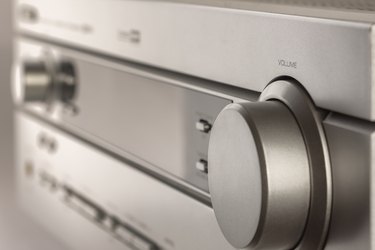
It takes a lot of time, effort and – usually – money to get your car stereo up and running at its best, so it's frustrating when your shiny new system gives you an error message instead of music. If your Kenwood is in protect mode, searching the internet for "Kenwood radio reset code" isn't going to cut it. It's not a setting you need to change; it's a warning that you have a potentially damaging problem with your installation.
Kenwood Protect Mode
Video of the Day
Unfortunately, Kenwood's documentation doesn't always do a good job of explaining this. The manual that comes with the KDC-BT340U, KMR-D372BT and several other models tells you to take your unit to a service center and leaves it at that. The manual for the Kenwood KDC-MP242U is a little more forthcoming. It explains that your stereo's speaker wire may have a short and offers options to fix the problem. The manual for the KAC-M1824BT gives an even more useful checklist. Aside from the potential speaker problems, it explains that the unit's protection can be triggered by overheating, by speakers of the wrong impedance, or by a malfunction in the receiver itself that sends DC power instead of an audio signal to your speakers. Armed with that information, you can start troubleshooting.
Video of the Day
Overheating Is Easy to Spot
The simplest problem to troubleshoot is overheating. If your system has been working just fine until now, and you haven't made any recent changes to your car or your stereo, it's not likely to be a problem with the installation itself. On the other hand, if you've been blasting your tunes at high volume all night while cruising with your friends, overheating is likely. Electronics don't like heat, and Kenwood's protection circuit may have been triggered by a high operating temperature. If that's the case, fixing the problem is simple. Turn off the receiver and let it cool for a few hours; then try again. If the protection mode warning doesn't go away on its own, press the reset button. If that doesn't work, disconnect the power lead from your receiver for 30 seconds and then reconnect it. If it still doesn't work, it's time to take it to the dealer.
Looking for the Short Circuit
If you've just installed the receiver or just added new speakers, a short circuit or a speaker wire running to ground is the likeliest reason for your Kenwood's protect mode to be triggered. Start by looking at the ends of the wires. If they're frayed and touching each other or any nearby metal parts, especially the terminals for another speaker, that's the problem. It's worth taking a look to see if any of the car's wiring might be shorting the speaker wires behind your receiver or amplifier. If neither of those examinations gives you any results, follow each run of wire from start to finish. Look for any places where it might be frayed or damaged or where the insulation has been sheared. If there's any chance at all for the wire to make contact with metal, it could be the problem. You can fix it by insulating the damaged area with heat shrink and then routing the wire away from the hazard that damaged it in the first place.
Resistance Isn't Futile
Have you ever leaned up against what you thought was something solid, only to have it move and leave you flat on the floor? That's what it's like for your receiver if your speakers don't have the right impedance or electrical resistance. Your speakers act as a resister in the amplification circuit, and if they don't provide enough resistance, the amp can overheat and shut off. Your speakers usually offer 4 ohms resistance, but if you hook them up in parallel – running wire from the positive terminal of each speaker back to the same positive output on the amp and then doing that with the negative wires as well – you reduce the impedance of that circuit. It's especially problematic if you've already bridged the amp to give higher output through fewer speakers. The math to check this is a bit complicated if you're not familiar with Ohm's Law, but you can use an online calculator to see if you've taken the impedance lower than your receiver can handle. If so, you need to use fewer speakers on that circuit or wire them differently to solve the problem.
Know When to Get Help
If you've done all the troubleshooting you know how to do and the problem still hasn't gone away, it's time to get professional help. Most of the time, it'll be one of the problems with your installation that keeps your Kenwood in protection mode, but it can also be caused by a failure in the receiver itself. If the unit is still under warranty, it's a no-brainer to take it to a dealer or authorized service center. If it is out of warranty, try shopping around for quotes and compare the cost of the repair to the cost of a replacement unit.
- JBS Power Centre: Kenwood KMR-D372BT CD-Receiver Instruction Manual
- Kenwood: KDC-MP242U CD-Receiver Instruction Manual
- CarID: Kenwood KAC-M1824 Digital Amplifier Instruction Manual
- Audio Gurus: Speaker Impdedance Rating, Explained
- Basic Car Audio Electronics: Series, Parallel and Series/Parallel Resistance